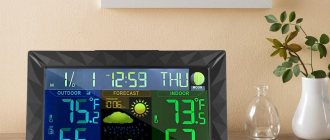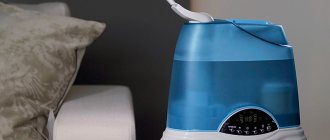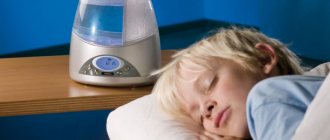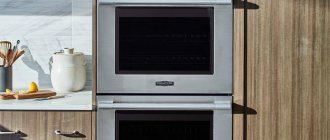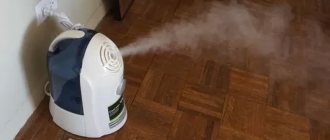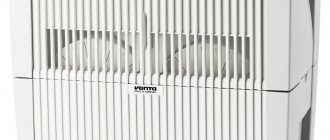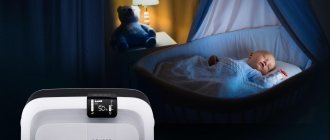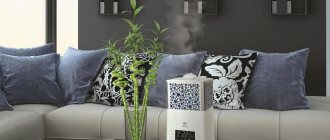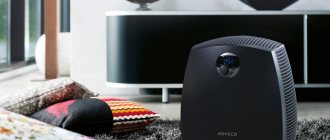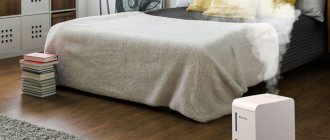Why are humidifiers needed?
An air humidifier is a unique device. It is necessary to create an optimal indoor microclimate.
Other important functions of this device include:
- maintaining the required level of humidity in the room;
- elimination of static electricity charges (they can arise in dry air);
- cleaning the air from dust and microparticles of dirt, etc.
Air humidifiers prevent the development of various diseases of the upper and lower respiratory tract. They have a beneficial effect on skin, hair and nails, preventing the aging process. These devices can also be used to prevent nosebleeds in adults and children.
Ultrasonic humidifier: disadvantages and advantages
User reviews and comparisons of ultrasonic humidifiers with other types of devices highlight 5 design advantages.
- Minimum power consumption. For budget-conscious people, it is better to choose an ultrasonic air humidifier, the operating principle of which does not require heating the liquid to the evaporation temperature.
- Low noise level. Modern models operate quietly, especially in night mode. This is convenient if the device is installed in the baby’s room - the chances of waking the child are low.
- "Independence". The device of advanced models allows the device to analyze the level of humidity in the room and adjust operating parameters based on the data obtained. The equipment starts when the humidity in the room drops to a critical level and stops when the optimal level is reached. You can set the start time so that the device starts working during the day while household members are at work, or in the middle of the night.
- Benefits for people with respiratory diseases. The “magical” properties of humidifiers advertised have not been proven, but optimal humidity in the room allows you to avoid the feeling of dryness in the nasopharynx. Devices with an advanced filtration system make it easier for allergy sufferers to breathe - such a device reduces the concentration of allergens such as dust or animal hair in the air.
- Safety. Its compact dimensions allow you to install the ultrasonic humidifier anywhere; household members will not be able to accidentally overturn the tank or interfere with the operation of the device. “Cold” steam does not burn and does not interfere with children and animals’ exploration of the world.
The device has fewer disadvantages. The main disadvantage is the lack of evidence-based research on the effectiveness of ultrasonic humidifiers in the fight against colds.
It is easier to breathe in a room with optimal humidity, but the equipment does not protect against viruses.
Another disadvantage is the need to use distilled water. Hard, unfiltered liquid shortens the life of the device and damages the surrounding furniture. When drying, the salts of the unrefined “cold” steam appear on surfaces in the form of a white coating.
How is an ultrasonic humidifier better than a steam humidifier?
Modern ultrasonic humidifiers outperform steam humidifiers in efficiency and safety. The first produces “cold fog” and requires less energy. The body of the ultrasound device does not heat up, and the steam from the nozzles does not burn.
Attention: if you care about the cleanliness of the air and surrounding space, choose a steam humidifier. When heated, hard water salts settle in the tank, and high temperatures disinfect the escaping steam.
Are ultrasonic humidifiers harmful?
Question to the expert
Are ultrasonic humidifiers harmful?
The degree of harm depends on the health status of household members and the operating characteristics of the device. If family members have chronic diseases, consult your doctor before purchasing equipment. Understand how changing humidity levels will affect your well-being.
Even if there are no contraindications to using the device, study the instructions, the operating principle of the ultrasonic humidifier and strictly follow the rules. Turn it on as needed to maintain optimal humidity levels, don’t forget to clean the device and change filters.
Check the integrity of the wires, keep them out of the reach of children - then possible harm will be reduced to a minimum.
General rules for operating air humidifiers
Before connecting the humidifier to the network, you need to check the tightness of its housing and cord. If the housing is cracked or the cord is damaged, the product cannot be connected to the outlet. If the device fails, you need to contact a service center.
It (like any other equipment) is guaranteed. But the warranty will be void if you repair the humidifier yourself.
Features of activating the humidifier
To turn on the humidifier, you must first connect it to the power supply by inserting the plug into the outlet. Then (depending on the type of device) you should press the on/off button on the unit body or activate the device using the remote control.
When the humidifier is turned on, the green indicator on its body lights up, and when turned off, the red icon lights up
All additional functions of the humidifier are indicated on the display after switching on. To activate them, press the desired button on the LCD screen.
Features of using different types of humidifiers
The humidifier should be placed on a dry and level surface. The machine must be in a stable position, otherwise it may tip over during operation. Tilt of the device may interfere with its normal operation.
You should not install the humidifier at a slight angle, even if it is well secured.
Before turning on a traditional type of humidifier, you need to place a filter in the water tray, attach the lower part of the device and secure the housing.
Then you need to fill the tank with distilled water and close the lid. After this, you should place the container on the lower part, turn on the device and select the most suitable mode using the switch on the body of the product.
If you need to turn on the steam humidifier, you should first fill it with water, keeping an eye on the liquid level indicator in the device. Then you need to turn on the device and select the operating mode.
During operation, the green indicator on the device body will light up. When all the water has evaporated from the tank, the indicator will turn red and the unit itself will automatically turn off.
When using an ultrasonic humidifier, one day before turning it on, you need to place the demineralization cartridge in a container with clean water. The next day, you need to fill the tank with water, close it with a lid and insert it into the housing. After this, you should install the part with the sprayer and turn on the unit.
Ultrasonic humidifiers are among the most modern and functional technology, and therefore they are often used in offices and other commercial premises.
If everything is done correctly, the green indicator on the device will light up. Then you need to select the appropriate mode and adjust the desired humidity level. When this parameter is reached, the humidifier will turn off on its own.
Safety precautions when working with a humidifier
Before turning on the humidifier, you should read its operating instructions. It provides general recommendations for using the device.
However, when using any type of humidifier, it is prohibited to:
- add liquid to the reservoir of the switched on device;
- use dirty water;
- rearrange the device plugged into the outlet;
- add flavoring agents directly to the water (there is a special compartment for this);
- pour water into the humidifier through the hole intended for the release of water vapor;
- block this hole, etc..
The operating time of the device depends on its design features. Steam humidifiers can achieve the desired level of humidification in just a couple of hours. But traditional models usually work slower and sometimes saturate the air with moisture for 10-12 hours.
Information on how long and at what mode the humidifier should operate in order to achieve the optimal level of humidity in the room can be found in the instructions.
Water is heavier than air, and moistened air currents automatically go down, and therefore it is better to install the device on a small elevation from the floor (for example, on a stool, coffee table, wall shelf or bedside table). Devices with large tanks (8-9 l) can be placed on a cabinet or high shelves.
When choosing the optimal location for installing a humidifier in a living room or office, you need to unplug it from the socket.
A small humidifier should be at a minimum distance of 50 cm from the floor. If you place the device on the floor, a small puddle will soon appear around it.
Due to the nature of its operation, this device should not be placed next to:
- electrical appliances;
- walls (otherwise unsightly stains may appear on the wallpaper);
- upholstered furniture;
- books and clothes;
- central heating radiators (on the contrary, they dry out the air and can negate the benefits of using a humidifier).
The distance from these items to the humidifier should be about 30 cm so that moisture does not settle on them. Fine particles of water (after all, steam is one of the physical states of water) that get on technical devices can disrupt the operation of any equipment.
There should be enough free space around a household humidifier with any operating principle for normal air circulation
If there is an aquarium in the room, then you should not place a humidifier next to it. This is simply impractical, because water also evaporates from the aquarium, humidifying the air. Those. a double humidification effect is created, which can also negatively affect the indoor microclimate. Due to too much humidity in the apartment, pulmonary diseases worsen, and mold appears on the walls.
If there are children or pets in the house, the device should be placed out of their reach. In this case, it would be appropriate to install even a small air humidifier on a cabinet or high shelf.
Sometimes something like a plastic grill or fence is designed for the humidifier to prevent small children, dogs and cats from reaching it.
If there are no small children or pets in the apartment, then the humidifier can be placed in the middle of the room at some distance from the furniture. But the device should not interfere with free movement.
It is also important to remember that the humidifier is powered by electricity, so it must be installed near an outlet. If possible, you should avoid using surge protectors, extension cords and adapters, since these are additional connections and unnecessary contacts.
How to properly use a humidifier in an apartment in winter and summer
The instructions for using an air humidifier for an apartment are quite simple. For the device to be useful, it is necessary, first of all, to pay attention to the quality of the water.
What kind of water can be poured into a humidifier?
The rules for using an air humidifier recommend pouring only clean water without unnecessary impurities into the device’s reservoir. In particular, the device is suitable for:
- distilled;
- bottled drinking water;
- home filtered water.
Traditional and steam humidifiers can use any of the following liquids. It is better to fill ultrasonic devices only with distilled and additionally demineralized water. Devices of this type do not heat the liquid, but spray it in the form of a cold mist. Hard particles do not settle at the bottom of the container, but enter the air in full, and even a small amount of them leads to a whitish coating on the furniture.
Attention! In steam and traditional devices, if necessary, you can use boiled tap water. It is absolutely not suitable for ultrasonic units.
The humidifier operating manual recommends regularly flushing the device's reservoir, regardless of its type and model. The algorithm looks like this:
- The remaining water is completely drained from the humidifier container.
- The tank is thoroughly washed under the tap.
- A weak concentration of vinegar solution is poured into the container and left for 30-40 minutes.
- After the time has passed, rinse the tank again.
Regular maintenance helps prevent the formation of limescale.
Even distilled water contains solid particles that settle on the bottom and walls of the container
Can a humidifier be used as a nebulizer?
Nebulizers and humidifiers work on similar principles. The latest devices, like inhalers, release an intense stream of steam or, in the case of an ultrasonic model, cold mist. At first glance, it seems that you can use a humidifier instead of a nebulizer to deliver atomized medication into the respiratory tract.
But in fact, using the device instead of an inhaler is not recommended. The reasons are as follows:
- Even when using a real nebulizer, at the moment of nebulization, about 30% of the drug is uselessly dispersed into the air. When using a humidifier, losses will be about 90%.
- Devices for normalizing the indoor microclimate are designed to spray clean water without impurities. If you pour a medicinal product into the device, then at best the filters will fail, and at worst the device itself will break.
The unit may be used as a nebulizer only as a last resort and on a one-time basis. For continuous use, you need to buy a medical inhaler.
Can I use a humidifier without a filter?
You can only use a humidifier without a filter if it is a steam device. Such a unit heats the water before supplying it to the room, and the hard particles present in the liquid settle at the bottom.
Ultrasonic models operate on a different principle. Using a high-frequency membrane, they break cold water into microscopic particles and then distribute it into the surrounding area in the form of mist. All mineral impurities remain in the wet suspension. The use of an ultrasonic device without elements that retain lime particles leads to the latter not only settling on furniture, but also entering the human respiratory tract.
Most humidifiers come with filters included. But from time to time, elements require replacement. The average filter service life is 3-4 months. The exact timing depends on the quality of the water and the intensity of use of the device.
A good humidifier should be additionally equipped with carbon, antibacterial and HEPA filters
How to properly use a humidifier for babies in the nursery
During the winter season, a humidifier is especially in demand in a children's room. Babies react sensitively to dry air. If the microclimate in the apartment is far from ideal, the baby may develop chronic asthma or allergies.
The mode of using an air humidifier in a nursery is generally standard. The device should operate continuously in winter with the central heating on, and in summer it is enough to run it for a couple of hours if really necessary. It is recommended to take into account a few more nuances:
- The humidifier must be positioned so that the child cannot reach it independently. This especially applies to models that release hot steam into the surrounding area.
- The humidifier should be positioned so that the water suspension does not fall directly on the child’s sleeping place or where he usually plays. Dampness is no less dangerous to the baby's health than excessive dryness.
Air humidity in the nursery should always be at the level of 45-62%. But if the child is sick, the indicator can be temporarily increased to 70% - this will help prevent the development of bacterial processes in the baby’s respiratory organs.
What kind of water can be used in a humidifier?
Not only the duration of operation of the device, but also the nature of the device’s effect on the human body depends on the quality of the water poured into the humidifier. If you use ordinary tap water in the unit, the salts and chlorides dissolved in it will enter the humidified air, and then end up in the respiratory tract of all people in the room.
Children suffer especially badly from bad water in a humidifier, because they breathe at a higher speed and intensity than adults, and therefore many harmful substances will enter their lungs and bronchi.
Also, using dirty tap water has a detrimental effect on the functioning of the device parts. Scale forms on them, and the elements quickly become unusable.
To prevent this from happening, you need to use only clean water (bottled, distilled, demineralized, spring or artesian).
In addition, you can pour boiled and filtered water into the device, but this is often not recommended.
Some chemical compounds (including salts) in tap water are not filtered and do not precipitate after boiling, and therefore can subsequently have a detrimental effect on the health of household members and on the operation of the humidifier itself.
Standing tap water will also not bring much effect. Typically, water is left to settle for 7-8 hours, assuming that in the first 2 hours, chlorine and hydrogen sulfide compounds evaporate from the liquid, and then heavy metal particles are removed from it. But in fact, it will still not be purified.
The best rule to follow is to only fill the humidifier reservoir with water that you can give to your child or drink yourself.
Today, many people are afraid to drink even filtered and boiled tap water, so why put it in humidifiers? It makes more sense to spend money on normal, clean water now than to look for money for medicine later.
Pure artesian water is even sold in vending machines on the streets, and it is inexpensive. Clean, moist air will automatically increase pulmonary immunity, and saving “on matches” (on elementary water!) will not lead to anything good.
If the humidifier does not use all the water from the reservoir in a day, it still needs to be changed and the container cleaned. The fact is that a warm and important environment is perfect for the growth of bacteria.
After turning off the device, you should empty all the water and wash the tank if the device will not be used for the next few hours
The humidifier should not stand with water. When servicing the humidifier and draining the water, it should be unplugged. Otherwise, you may get an electric shock.
Use humidifiers as intended and correctly
Different models produce humidification using their own evaporation principle: cold, steam or ultrasonic. Each humidifier has specific safety requirements and recommendations for use.
Cold humidifiers
They not only humidify, but also clean the air from dust. Particularly effective use in rooms up to 80 m², where there are children.
- Before turning on, you need to keep the device at room temperature for an hour.
- Place it on a horizontal surface so that there is easy access to it when working.
- Turn on the device when the air temperature in the room is from 5 to 30 degrees and the relative humidity does not exceed 80%.
- The efficiency of the device will increase if it is located near a heat source.
- It is better to fill the water tank with distilled or fresh filtered water. This will prevent the formation of limescale on objects located near it and inside the device.
- The maximum humidification effect occurs after 10-15 minutes, if the water temperature is not higher than permissible (40 °C).
- You can add a fragrance to a special niche or soak a cotton swab with it and place it in the tray.
It is unacceptable to add essential oils and other special flavors to the tray or tank.
Depending on the capacity of the humidifier and the dryness of the room, the device can continuously maintain humidity for several days. In modern models, when the water level drops below the permissible level, an automatic shutdown may occur.
Maintenance is very simple: the container needs to be cleaned every two weeks, the moisturizing discs every month.
Steam humidifier
This humidification option is more suitable for large or frequently ventilated rooms. At home, in addition to moisturizing, they use additional functions: an inhaler and an aroma lamp.
- It is more economical to use a device with a power corresponding to the volume of the room for humidification.
- Mobility, light weight and dimensions allow it to be installed in any room.
- Any water can be poured. If it contains salts and minerals, they are not sprayed, do not enter the respiratory tract, or onto plants and furniture.
- If the design does not have a hygrometer, the operating device needs to be monitored. Otherwise, the humidity may rise above normal.
- It is not safe to leave a steam humidifier running unattended, especially if there are small children in the room.
- The surface of the evaporator must be regularly cleaned of mineral deposits. Anti-limescale discs will help reduce scale formation.
If you want to save money, use water with minimal hardness, this will reduce energy consumption.
Ultrasonic humidifier
These silent humidifiers are effective for home use. Especially if there are objects in the room that require delicate handling - antiques, musical instruments, parquet.
However, they also have a serious drawback. Ultrasonic humidifiers do not have filters, and therefore you can only use distilled or at least boiled water. Salts, microelements and pathogenic bacteria contained in poor-quality water can end up in the room along with water dust. Marks will be visible on furniture and clothing.
How to add oil to a humidifier?
Not all humidifiers can add aromatherapy oils. Under no circumstances should oil be poured directly into the spray tank. The device must support the aromatherapy function and have a special compartment into which essential oils are added and specific compounds are poured.
Such devices include:
- steam humidifiers;
- ultrasonic models;
- devices with a washing function.
Their design includes a special cassette or container. This is where the oil is poured, which is sprayed parallel to the water during operation of the humidifier. All aromatic oils poured into the spray unit must be of high quality and original.
After each procedure, you need to thoroughly rinse the device (including the cassettes for aroma oils) so that different oil liquids do not mix with each other
In this case, the volume of essential oil used depends on the area of the room. Experts recommend using no more than 5 drops for every 15 sq.m. area. If these proportions are violated, all the benefits of aromatherapy disappear, headaches, allergic reactions and attacks of nausea may occur.
As for the duration of the procedure, a humidifier with essential oils should not work like a regular wash. When using for the first time, it is better to turn off the device after half an hour or an hour of aromatherapy and look at your condition.
If dizziness or increased blood pressure occurs, the duration of the session should be reduced.
Using aroma oils in a humidifier
You can use essential oils or special solutions for aromatization only in those humidifiers in which this option is provided structurally, which is usually written about both on the packaging and in the instructions. Humidifiers with the “aromatization” option have a special tray for oils. It is strictly forbidden to add foreign substances to a container of water. The presence of aromatization does not depend on the type of humidifier. It may or may not be present in any type of device: steam, ultrasonic or “cold”.
We recommend reading: How to choose the right long-burning solid fuel boiler - details and subtleties
It is important to use substances that are, in principle, intended for aromatherapy, of high quality. General rules for dosage are 5 drops per 15 square meters of area. An overdose can cause side effects: allergies, dizziness and migraine attacks, nausea.
Aroma oils should be used with caution in a humidifier.
You should not use fragrances every time you turn on the humidifier. The first time the aromatic oils are added for an hour, no more, and the body’s reaction is monitored. If everything is in order, the time can be increased. If problems arise, flavorings should be abandoned.
You can read more about humidifiers with aromatization function here.
How to clean a humidifier?
Any humidifier needs periodic cleaning. To descale the device, you need to take out a water container and disconnect all possible parts from the device. If there is any remaining water in the tank, it must be poured out and the tank must be thoroughly rinsed under the tap.
Before pouring detergent into the humidifier tank, the body of the device must be wiped with a soft cloth and a solution of ordinary table vinegar.
The humidifier membrane is cleaned with a special brush, which is sold complete with the device. If this brush is lost, it can be purchased separately at hardware stores.
As an alternative, a small sponge without metal threads or a fleece cloth is sometimes used. To maintain the tightness of the sealing material, you need to thoroughly dry the device between uses by removing the plug.
To clean the water tank, only soft cloths should be used. Brushes with a hard surface may cause scratches inside the tank. If too much scale has accumulated in the container, you need to take a toothbrush with soft bristles and regular table vinegar 9-15%.
To clean a humidifier with vinegar, you need:
- Open the balcony or window, as acetic acid vapors have a negative impact on health.
- Dilute half a glass of vinegar (100 ml) in 2.5 liters of clean water at room temperature.
- Pour the resulting mixture into the tank of the device.
- Plug the humidifier into the outlet and run it in fast mode for an hour (the spout of the device should be turned towards the window; it is better to leave the room during this time, closing the door tightly).
- Turn off the humidifier, disassemble and thoroughly rinse each part with water.
In addition to vinegar, you can use citric acid, soda, hydrogen peroxide and chlorine bleach to clean the device. Citric acid helps remove plaque safely.
Baking soda destroys putrid film and mold inside the device, which can appear due to high humidity. Hydrogen peroxide disinfects the humidifier reservoir. Bleach destroys pathogenic microflora in the tank and prevents its reproduction.
In addition to folk remedies, you can use commercial anti-scale preparations to clean the humidifier: Top House, Luxus Professional Technics, Unicum, BONECO A7417 Calc Off, etc.
The filters in your humidifier need to be changed every few months. The exact replacement time depends on the type of device and the quality of the water used in the device.
These filters also need to be washed periodically under running water. You cannot use aggressive chemicals to clean them: its residues cannot be completely washed off with water.
The influence of open vents on the operation of the humidifier
Any humidifier is designed to work in a room of a certain area. If the device’s passport says that it is suitable for humidifying a room of 20 sq.m., then for a room of 40 sq.m. the unit will be useless. At the same time, the device can provide a normal microclimate only if all doors and windows in the room are closed.
If a window, door or window is open in the room, the efficiency of the humidifier will decrease. This will happen for two reasons. Firstly, due to open doors and windows, the area of the room will increase. Secondly, dry air will enter the room from the street or from other rooms and reduce humidity.
The stronger the influx of dry cold air from the street, the faster the humidity level in the living room will decrease
Moreover, air humidity directly depends on its temperature. Cold air contains less moisture than warm air. For example, at +20 the air contains 17.3 g/m3 of water vapor, and at 0 degrees the maximum content is already 4.84 g/m3.
If you want to ventilate the room, then it is more rational to do this before turning on the device. But you shouldn’t leave the humidifier on all night with the window closed. Sleeping in a stuffy room, even with normal humidity, is unpleasant.
In the cold season, due to working radiators or heaters, the microclimate in the room will resemble the tropics: it will become hot and humid
A humidifier should be used not only in winter, but also in summer. The air in the apartment may become too dry due to actively operating air conditioners and climatic (weather) factors. For humidification in summer, it is best to use models with cold steam and ultrasonic devices.
The purpose of household humidifiers to create a healthy indoor microclimate
The normal air humidity in summer is 40%-60%, in winter – 35%-40%. For good health, you must always adhere to these indicators. The seeming harmlessness of too dry or too humid air is actually fraught with danger.
Low humidity leads to frequent headaches. A person may have no idea about the causes of illness if he does not know about the effect of low humidity on the body. There may be a sore throat, sore throat and difficulty swallowing. A large amount of dust, inevitable with a lack of humidity, can provoke allergies, which over time can develop into bronchitis and asthma.
When there is a lack of moisture, a person feels persistent fatigue and drowsiness, and has difficulty concentrating. The skin dries out and ages quickly. In children, dry air can cause frequent colds, as it reduces the protective functions of the mucous membranes and skin.
Low humidity is also harmful to things. Wooden furniture dries and cracks, parquet floors dry out, fabrics become electrified. In rooms with dry air, indoor plants do not breathe and dry out quickly.
A humidifier is used to combat these problems. After turning on the device, breathing in the room becomes much easier, negative symptoms recede. However, it is important to ensure that the humidity does not exceed the upper limit of the norm. Otherwise, mold and the smell of dampness will spread throughout the apartment.
We recommend reading: Do-it-yourself installation of a heating system from corrugated stainless pipes
Typical problems when using a humidifier
Sometimes a number of problems arise when using air humidifiers. At the same time, you can deal with many device malfunctions yourself.
If the humidifier does not turn on, you need to check the presence of water in the tank and make sure that the device is actually connected to the mains. Often, users simply forget to plug in the humidifier and, as a result, cannot understand for a long time why it does not work.
If fine water dust does not come out of the steam outlet, then you need to thoroughly wash the device. These holes are often clogged with residual detergents. In addition to additional cleaning, you can use the regulator to set a higher humidity percentage.
Also, the absence of steam sometimes indicates that the liquid reservoir is overfilled and the supply channel is flooded. In this case, you need to drain some water and turn on the device again.
If this does not help, you need to check the condition of the membrane and the mechanism that drives it. If they are damaged, you will have to contact a service center.
If the spray is too weak, accompanied by noise, you need to check the amount of water in the container. This can happen if there is no longer liquid in the tank, but the device does not automatically turn off.
In ultrasonic models, such a malfunction may indicate contamination of the ultrasonic transducer. In this case, the converter must be removed, cleaned, dried and installed back into the humidifier.
If a whitish coating appears on the walls of the humidifier and objects in the room, you need to change the filter and start using purified distilled water
If an unpleasant odor occurs from a working humidifier, you need to check the water and membrane. A similar smell may indicate that the water in the tank has stagnated and bloomed. Then you need to drain the liquid and wash the tank. If the membrane itself is dirty, you should thoroughly rinse the emitter with clean water and dry it well.
If the display on the device does not work (does not light up), then it is better to contact a service center specialist. Such malfunctions indicate a breakdown of the electronic component of the device.
The following article will introduce you to the instructions for making a simple device for air humidification, which we advise everyone interested in improving the microclimate of the surrounding space to read.
Conclusions and useful video on the topic
Proper use of a humidifier increases its effectiveness. When installing the device, you should read the instructions and find the most suitable place for the device in the room.
Also, before you start using the humidifier, you should watch the video instructions to avoid common mistakes:
The humidifier can be used both in the apartment and in the office. You can even let children near the device, just tell them the basic rules for using the device in advance.
Would you like to share your own experience in choosing, operating and maintaining a humidifier? Do you have useful information on the topic of the article that is worth sharing with site visitors? Please leave comments in the form below, ask questions, post photos.
How to set up a household humidifier before turning it on
- do not rush to turn on the device immediately after purchase, it should be at room temperature for at least an hour,
- read the instructions, carefully study all points of the operating rules,
- decide on the installation location,
- remember that the temperature in the room where the device will be located must be no lower than +5 and no higher than +30 degrees,
- pour cold water into the water compartment,
- connect the device to power supply,
- turn on by pressing the power button,
- select the device operating mode you need,
- After switching off, rinse with water and dry.

